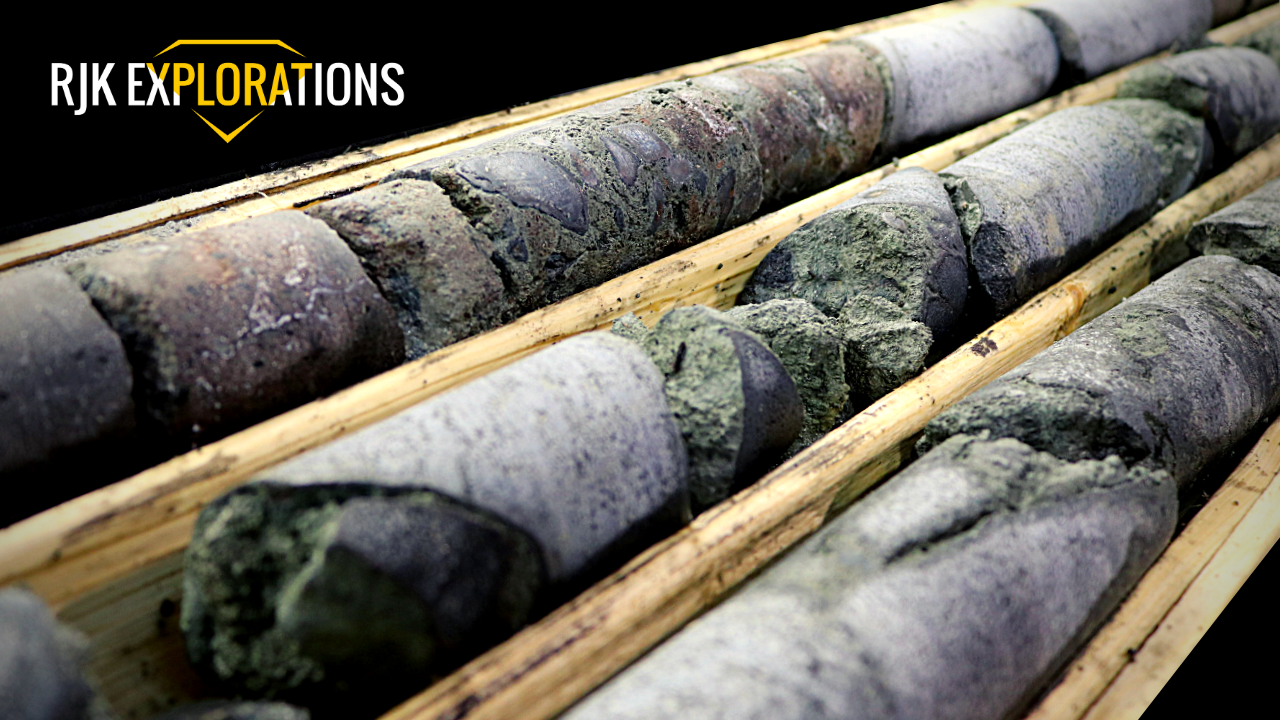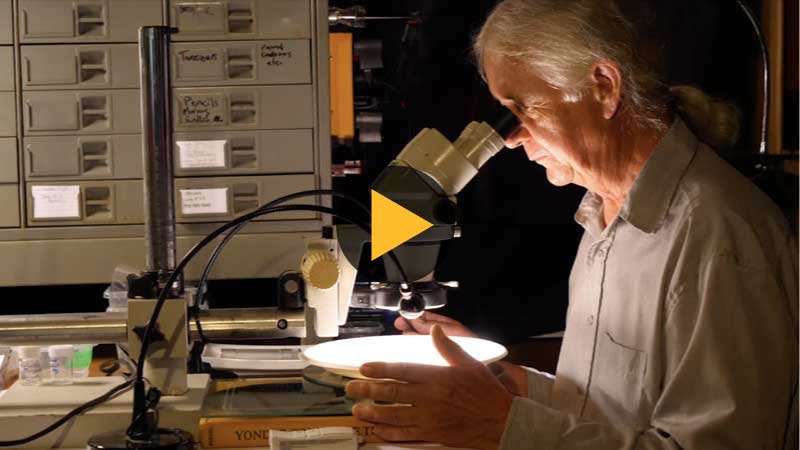
Independent Kimberlite and Diamond Consultant Dr. Jim Renaud Explains the Chemistry Significance of RJK’s Discoveries. It’s Possible that the Paradis Kimberlite could Represent the Source of the 800ct Nipissing Diamond
Stock Symbols: TSX-V: RJX.A | US OTC: RJKAF
Be the First to Know About Our Diamond Discoveries.
8 Large-Tonnage Kimberlite Discoveries in the Last Year
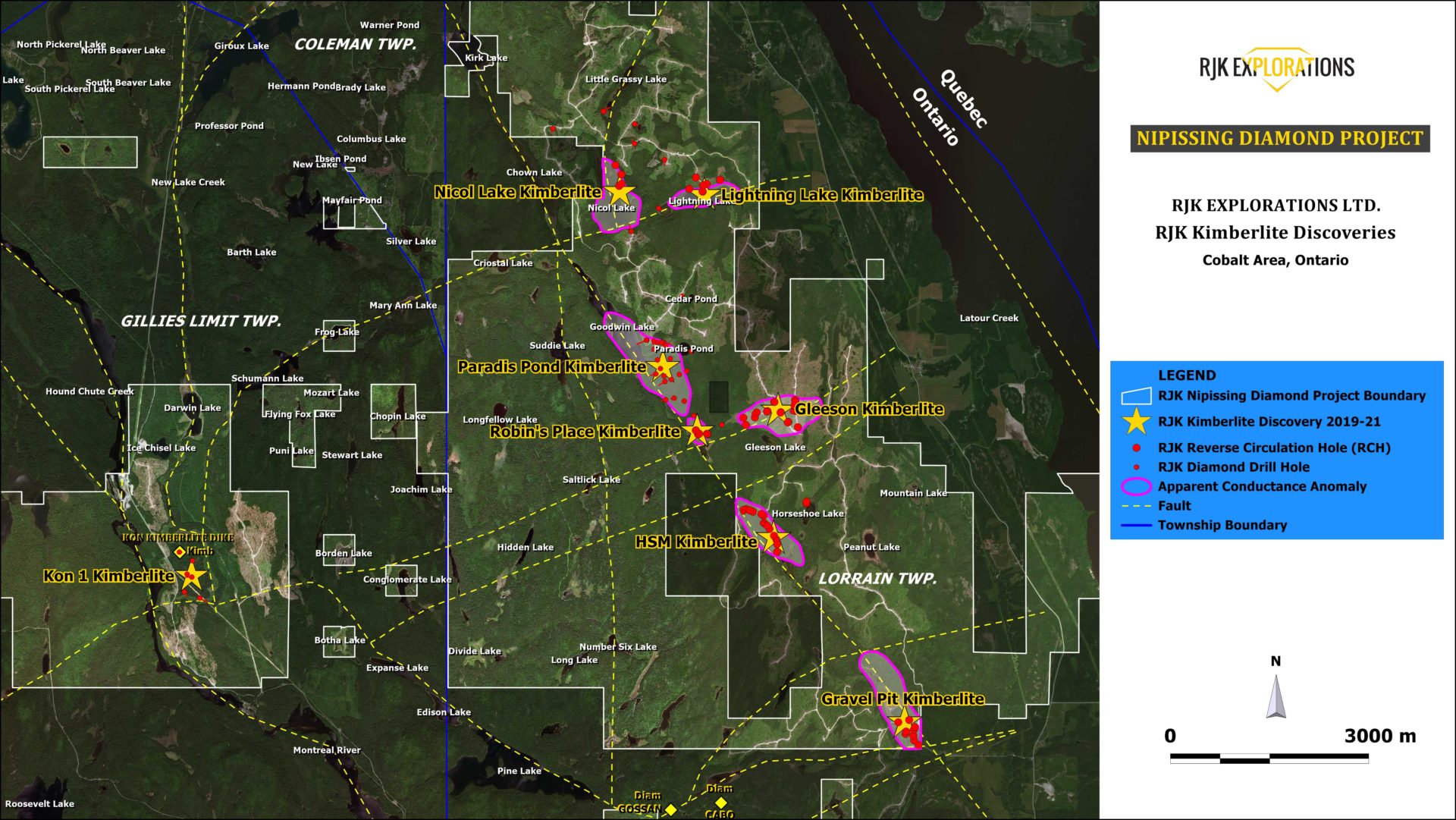
Historical Evidence of the 800ct Nipissing Diamond Discovery Location
Between 1903-1905, the silver mines of Cobalt were discovered. During the same period, a large gem was found by a settler in the area, who unfortunately did not know the stone was a diamond. Much of the land around the mines had already been staked, so if the gem was discovered on someone else’s land claims, the discovery location likely would have been kept secret.
In the summer of 1906, the MP of the Nipissing District, Adolphe Aubin, bought the diamond from the settler. Mr Aubin had the diamond authenticated, and sent it to New York to be cut by Tiffany & Co. Newspaper articles stated it was the size of a “bantam hen’s egg” with a “yellowish tinge.” They named the stone “The Nipissing Diamond” after the district in which it was found. In 1906, the Nipissing District encompassed the current Temiskaming District, introduced in 1910-1911.
In September of 1906, Father Charles Paradis had the diamond in his possession long enough to sketch it for The Mining Journal. Diamonds have a specific gravity of 3.52. Using the dimensions of the image below, and the formula mass = density x volume, the result gives a weight of 0.176kg or 880 carats. 5%-10% of the weight was subtracted due to slight irregularities, leaving 792-836 carats as an appropriate estimation.


In November, 1906, The Montreal Herald reported that Tiffany and Co., who cut and sold the Nipissing Diamond for Adolphe Aubin, were sending a team west of Temiskaming to search for more diamonds. They would not have done this without knowing the general vicinity where the Nipissing Diamond was found. However, Tiffany’s exploration team likely would not have known that glaciers repositioned surface materials. Therefore, it is likely that the explorers would’ve searched in the same area as the discovery, instead of up-ice. (Based on RJK’s most recent discovery, the diamond may have not been glaciated very far)

RJK contacted Tiffany and Co. for further details, but they claimed to no longer have historical records on the sale of the Nipissing Diamond or the expedition location west of Lake Temiskaming. Coincidentally, the “Crater of Diamonds” deposit was discovered in Arkansas at the same time as the Nipissing Diamond. It was reported that Tiffany and Co’s top diamond expert, George Frederick Kunz, travelled to Crater of Diamonds instead of spending the winter in Northern Ontario. In a search of historical land claims, RJK did not find any claims from anyone directly associated with Tiffany and Co. in the autumn or winter of 1906. However, in February, 1907, a group of New Yorkers staked land claims nine kilometres south of the silver mines of Cobalt. Among them were Herman and Hartwig Baruch, who were brothers of “The Lone Wolf of Wallstreet,” world-famous financier Bernard Baruch. They staked claims in an area reported to be granite, with no silver outcropping nearby. It seems there was no obvious reason to stake claims there for silver, but the area does have a strong kimberlite indicator mineral trend, suggesting there is a local kimberlite nearby. (RJK has discovered a potential silver target located west of their claims, named Criostal Lake)
The Baruch and Tiffany families both lived in 31 County Metropolitan area New York, and later in life, Louis Comfort Tiffany’s foundation was a donor to Baruch College, further connecting the two prominent families. It is a possibility that the Baruchs financed the Tiffany Expedition, and if so, the location of their claims could be the location where the Nipissing Diamond was discovered.


The Baruch claims expired after one year, with the brothers moving on in the region to pursue silver, as the level of wealth coming out of the silver mines was staggering.
It is interesting that the Baruch claims encompassed a wagon road completed by 1905, connecting the silver mines of Cobalt to a farming settlement founded by Father Charles Paradis (who sketched the Nipissing Diamond). Most diamonds are discovered below surface, so it is possible the settler who found the Nipissing Diamond unearthed it while building this wagon road.
A second possible discovery site was located by the Bishop family in 2016. While prospecting for diamond indicator minerals, they discovered a 50 m long, man-made trench located in the middle of a granite field with no outcropping nearby. The trees and weathering in the trench date back about a century, and when the longitude and latitude were overlaid on a map, the location crossed the historical wagon road. The trench returned strong KIM results in till samples. The question must be asked, why would anyone dig there, if not for diamonds? (RJK has drilled kimberlite 200 m west of the trench, within 2 m of surface, and it may extend closer)
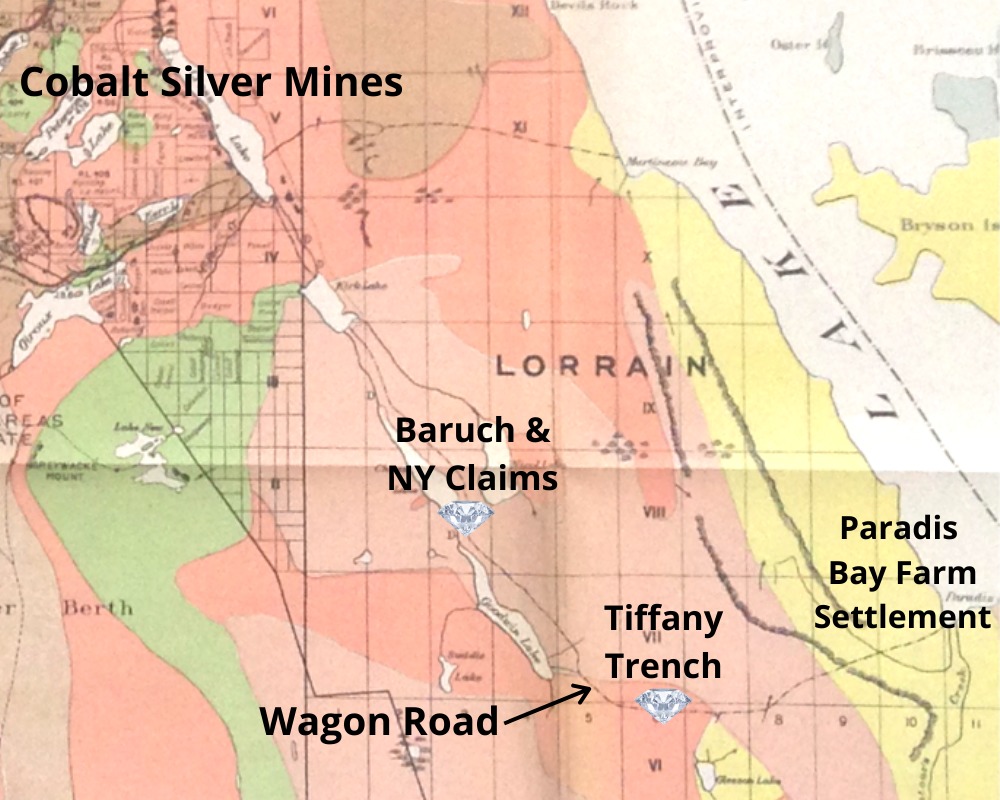
Paradis Diamondiferous Kimberlite Discovery
Paradis Pond was RJK’s top target when we first began drilling. The area was originally drilled in 2019 with drill holes PP-19-02 to PP-19-05. All intersected what appeared to be kimberlite within 4-6m from surface. The cores were sent to two independent labs and each reported the rock tested negative for kimberlite. In February of 2020, after Peter Hubacheck was hired, he advised RJK to test the core for diamonds. Charles E. Fipke’s lab, CF Mineral Research used caustic fusion and on April 1, 2020, RJK announced the 22kg sample returned 18 micro-diamonds of various colours. The drill core also contained 29 typical indicator minerals originating from the diamond inclusion zone. A subsequent 160kg sample was sent for further analysis, at which point Dr. Fipke informed RJK Explorations that the Paradis kimberlite appeared to be similar in composition to the Letseng Mine, in Lesotho, Africa, which has the highest dollar value per carat in the world, and has produced some the largest diamonds ever recorded.
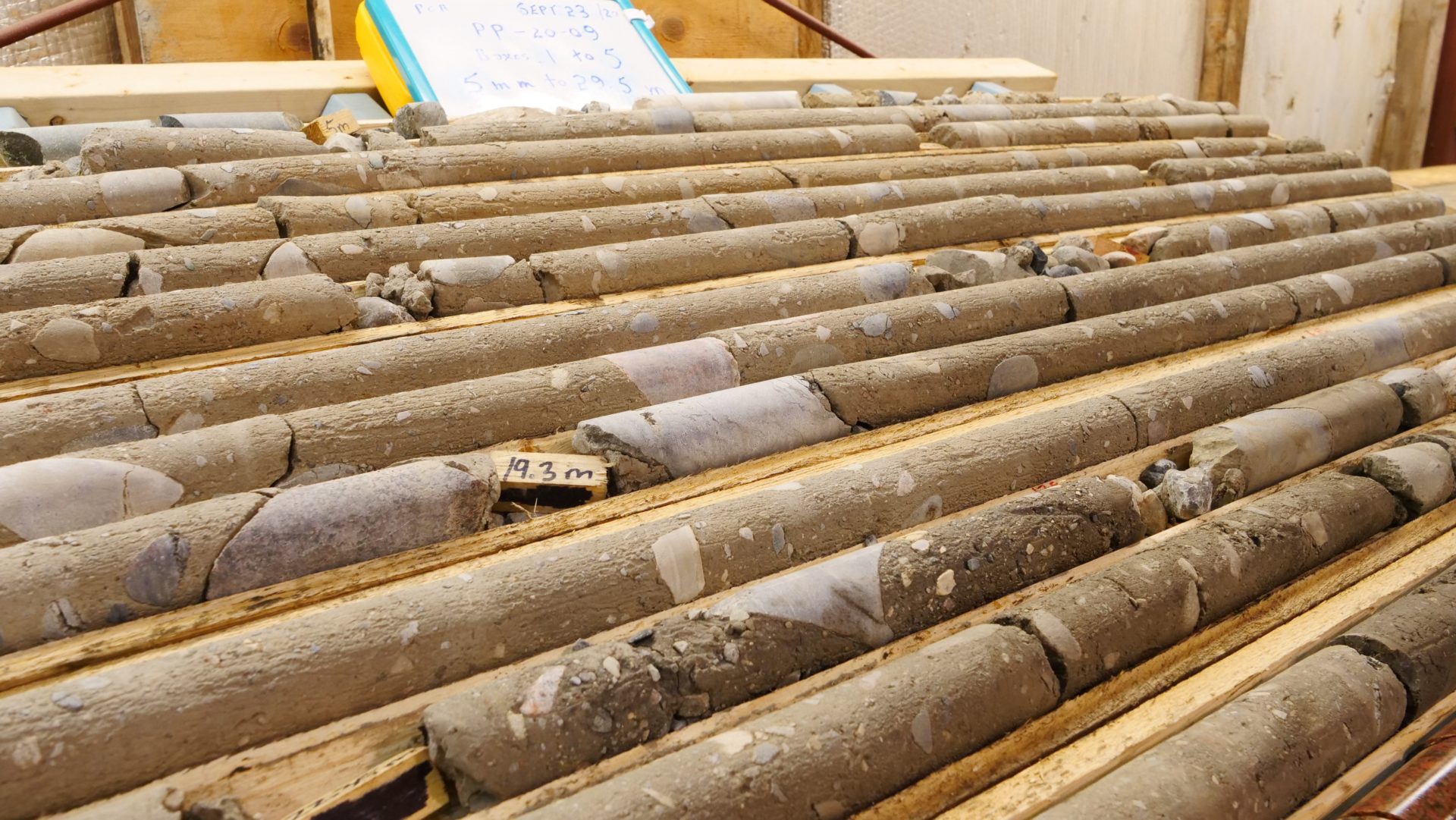
As of February, 2021, RJK had drilled over 70 holes into 8 different kimberlites, as shallow as 1 m from surface. The material is a typical tuffistic kimberlite breccia. For Paradis, a creek cuts across the kimberlite from Paradis Pond, to Goodwin Lake, adding a 3rd possible location where the Nipissing Diamond could’ve been found, if it did originate from the Paradis Kimberlite body.
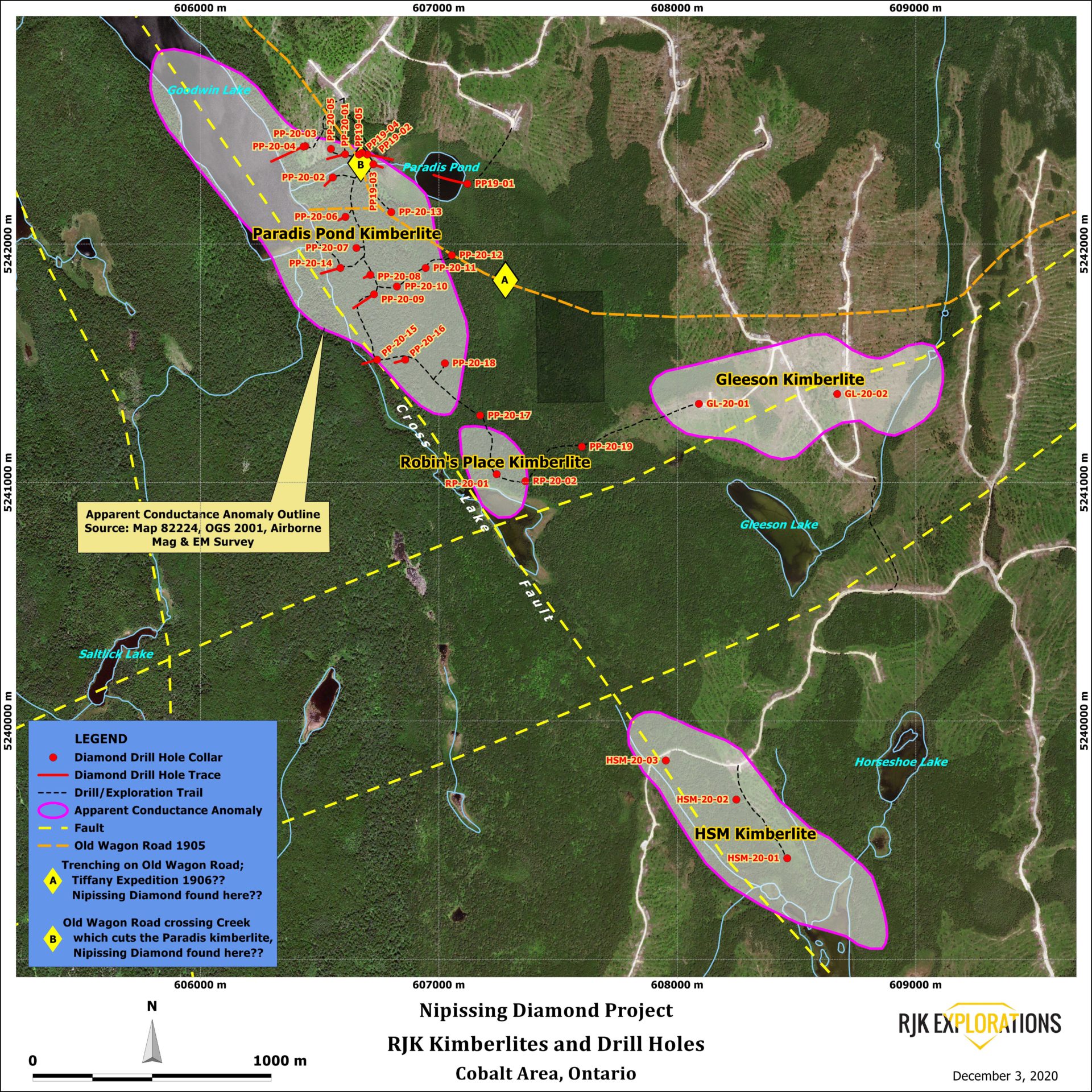
RJK’s kimberlites are associated with electromagnetic conductance signatures, as they are near-surface, and water-saturated. It is possible that this kimberlites erupted underneath a glacier as early as 16,000 years ago, but that theory is not yet confirmed.
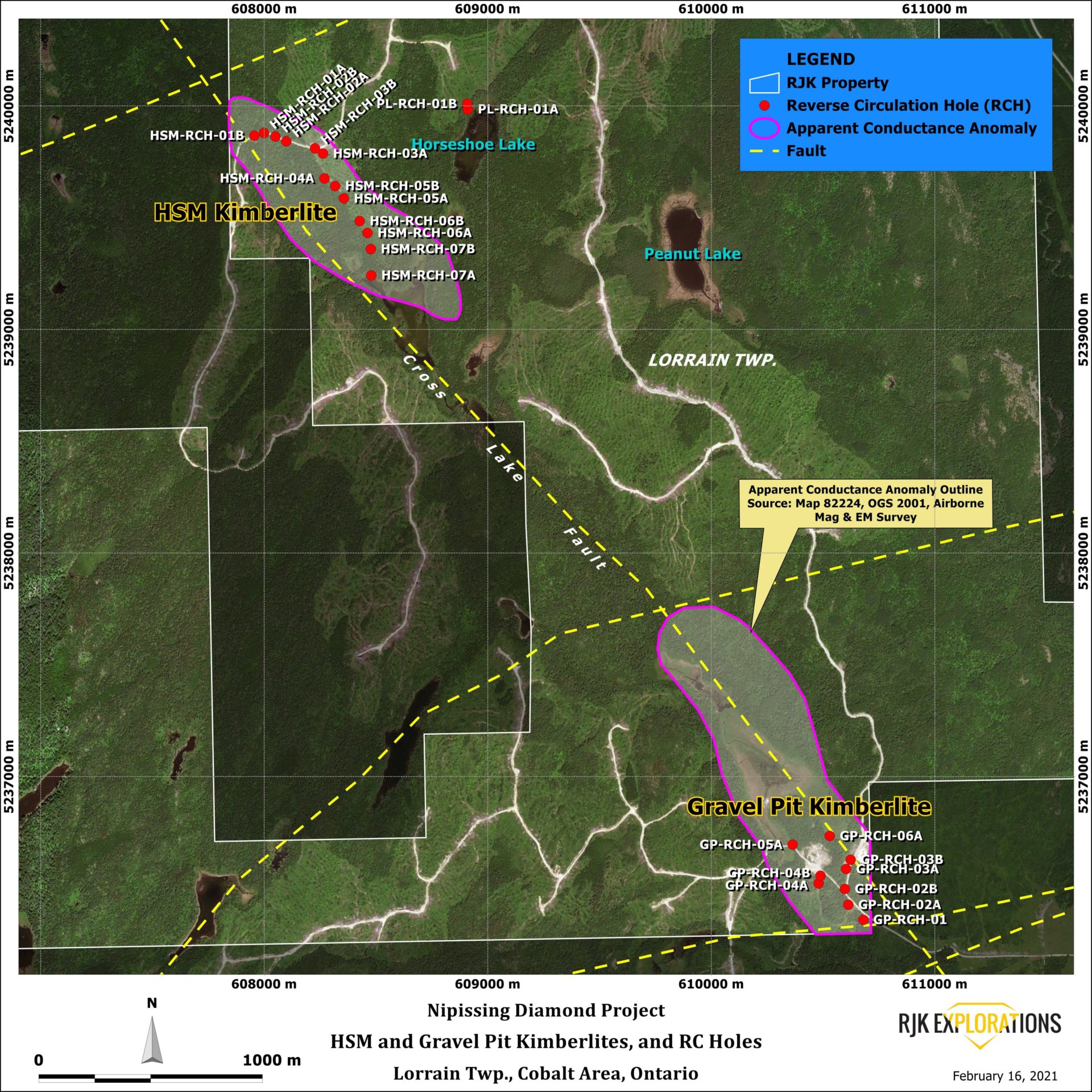
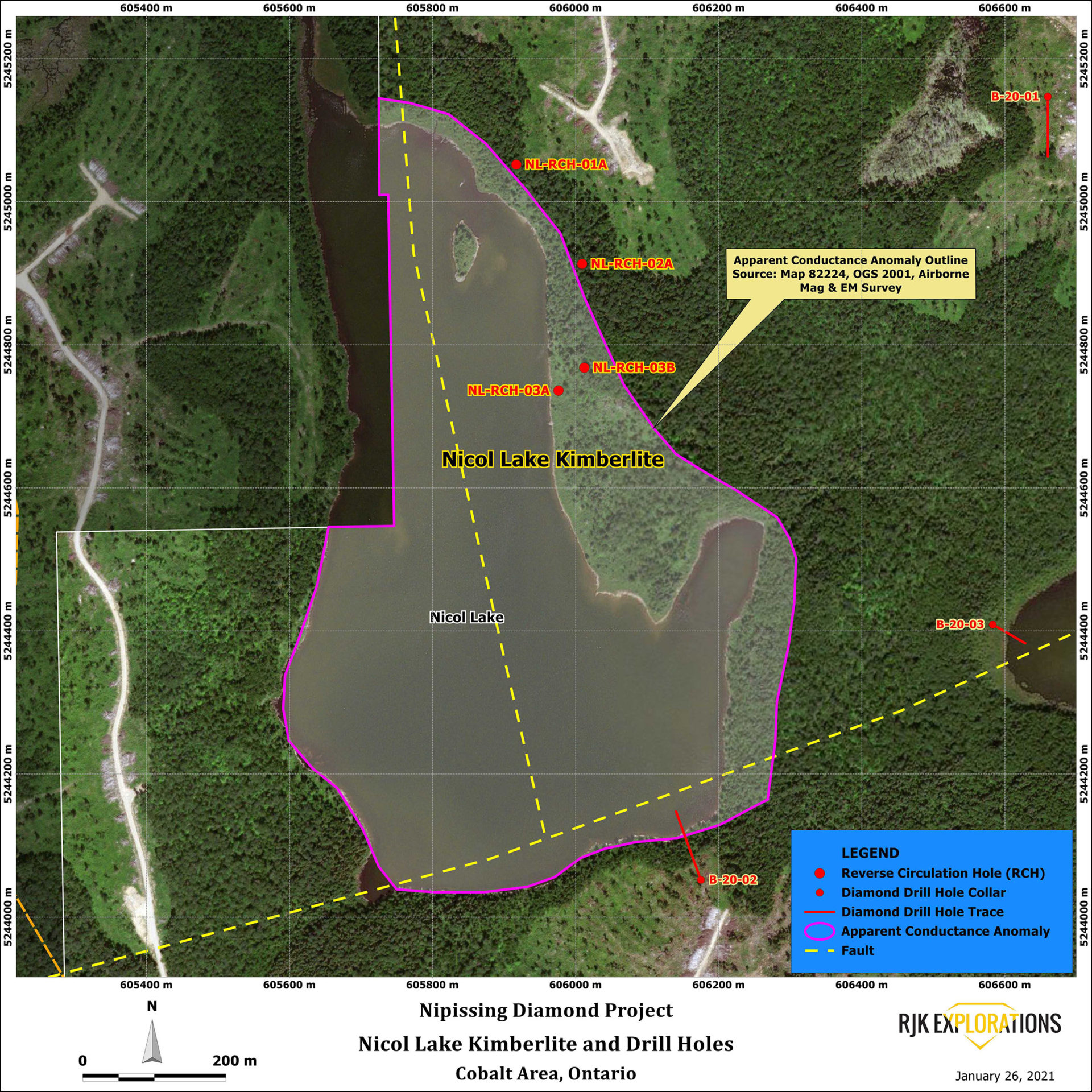
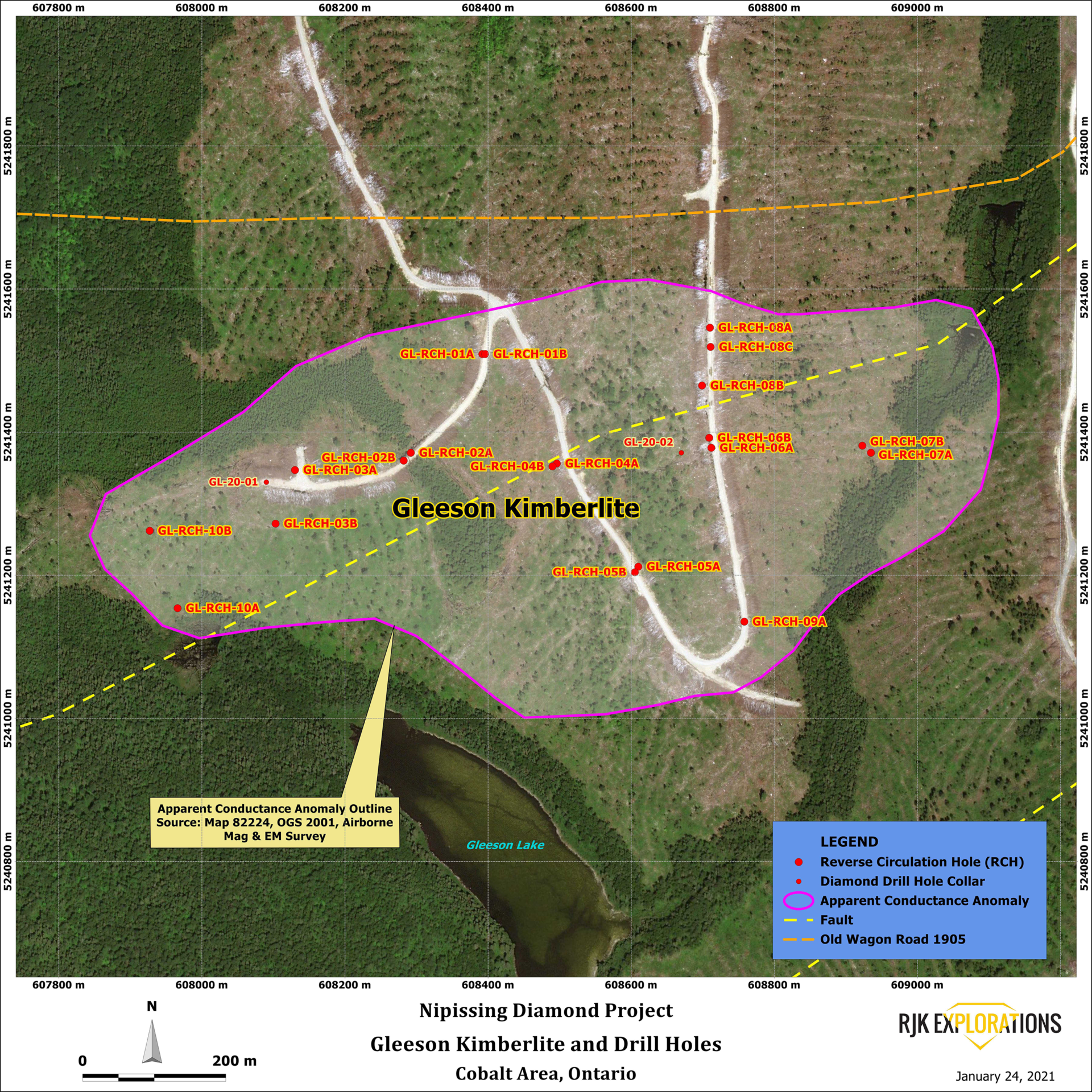
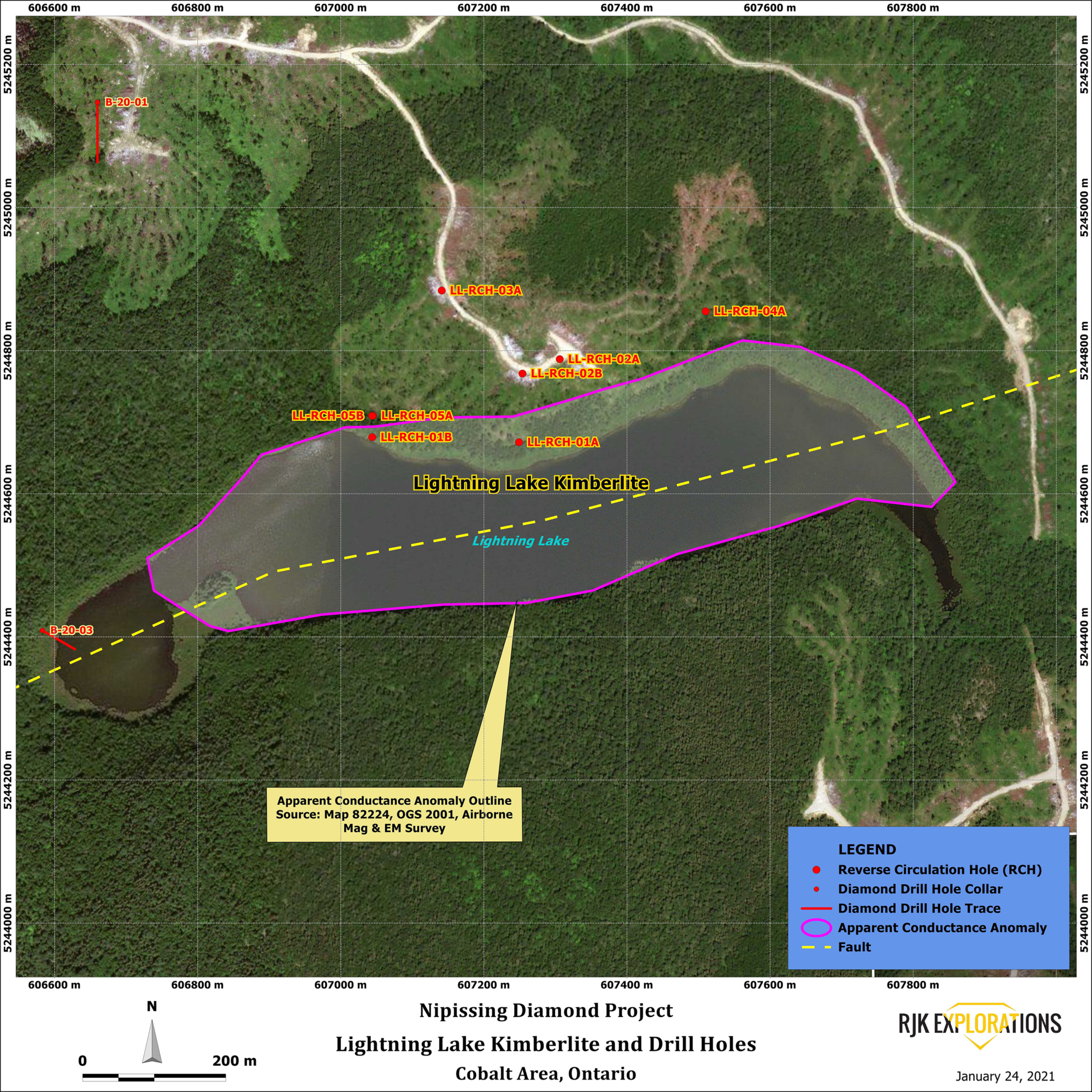
Additionally, there is a large gravity low area associated with the Paradis kimberlite and the Gleeson and Cross Lake targets. To the north of the gravity low, there is a large magnetic high alteration zone, estimated to begin between 300-500m below surface. This target, in the middle of two high-grade silver mining camps, has never been drilled. The silver camps are secondary sources of silver, and the heat source that brought the silver in Cobalt to surface has never been identified.
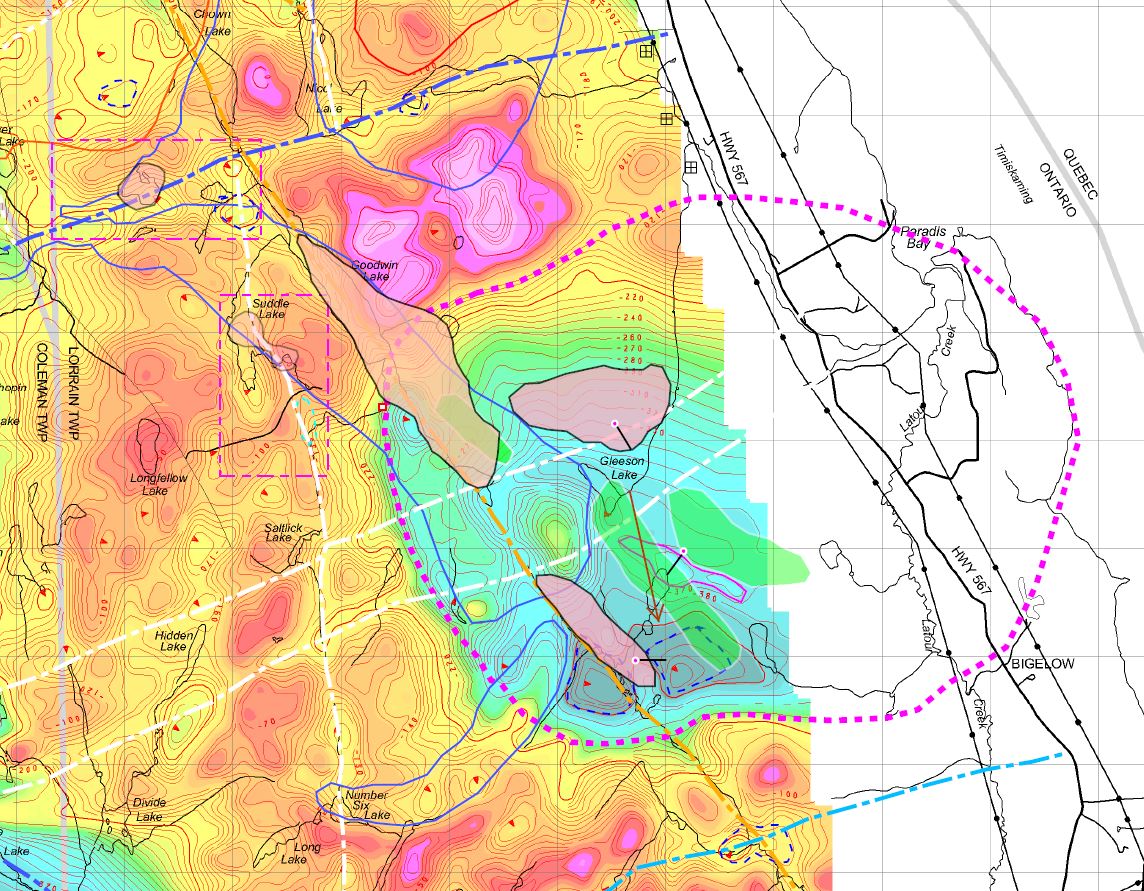
Kon Kimberlite Discovery
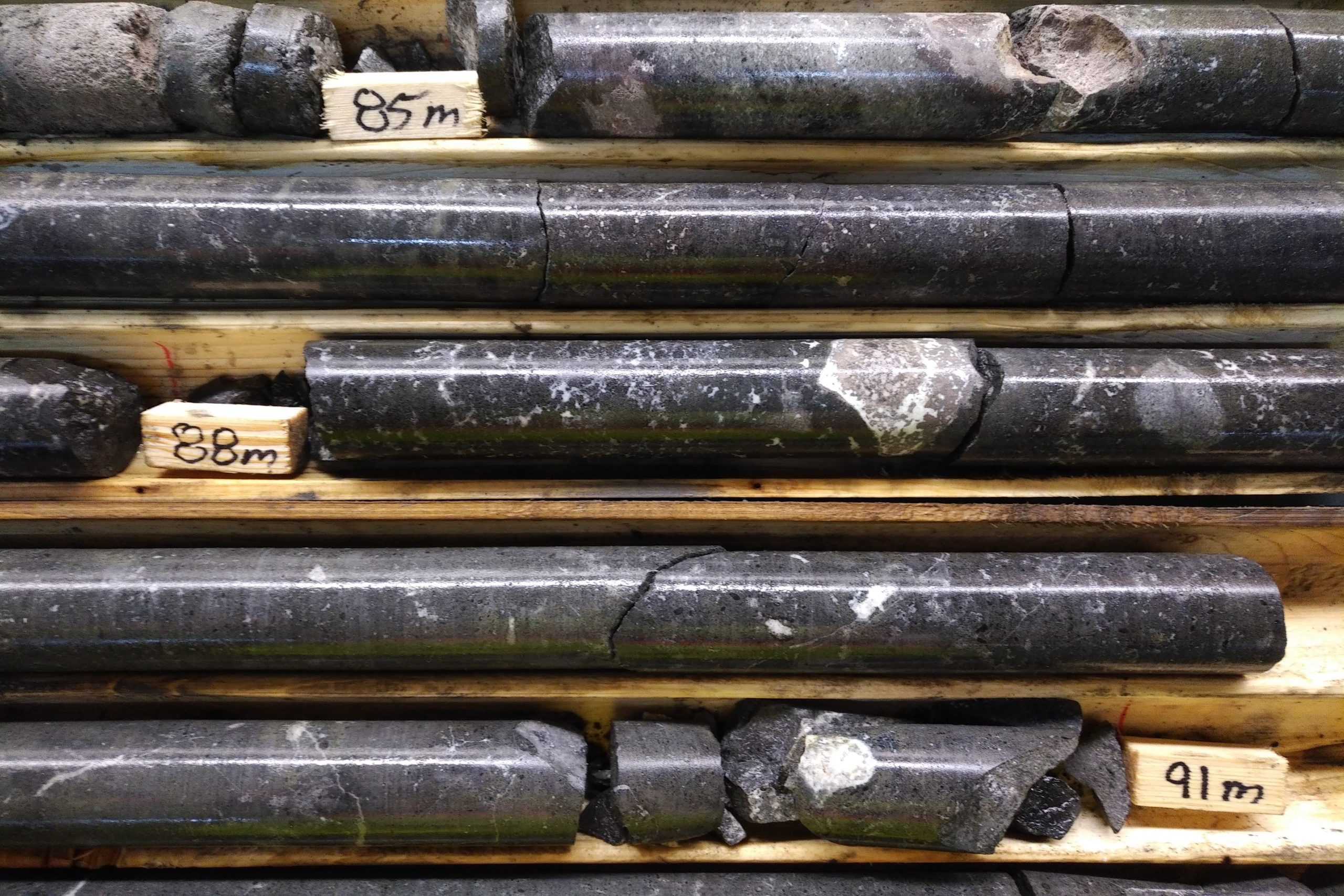
The Kon kimberlite was drilled in January, 2020, and announced February 4th. The kimberlite is a sill, with its origin still to be discovered. A sample of 277 kg of hypabyssal kimberlite was sent for testing returning 7 microdiomonds. 44 KIM grain determinations commonly originating in the diamond stability field were identified in the core. There are five known phases located within a 250 m x 200 m magnetic low signature, with a current true thickness of 80 m. The drill intersected kimberlite as shallow as 10 m from surface. There are many additional targets surrounding the Kon 1 discovery yet to be drilled.
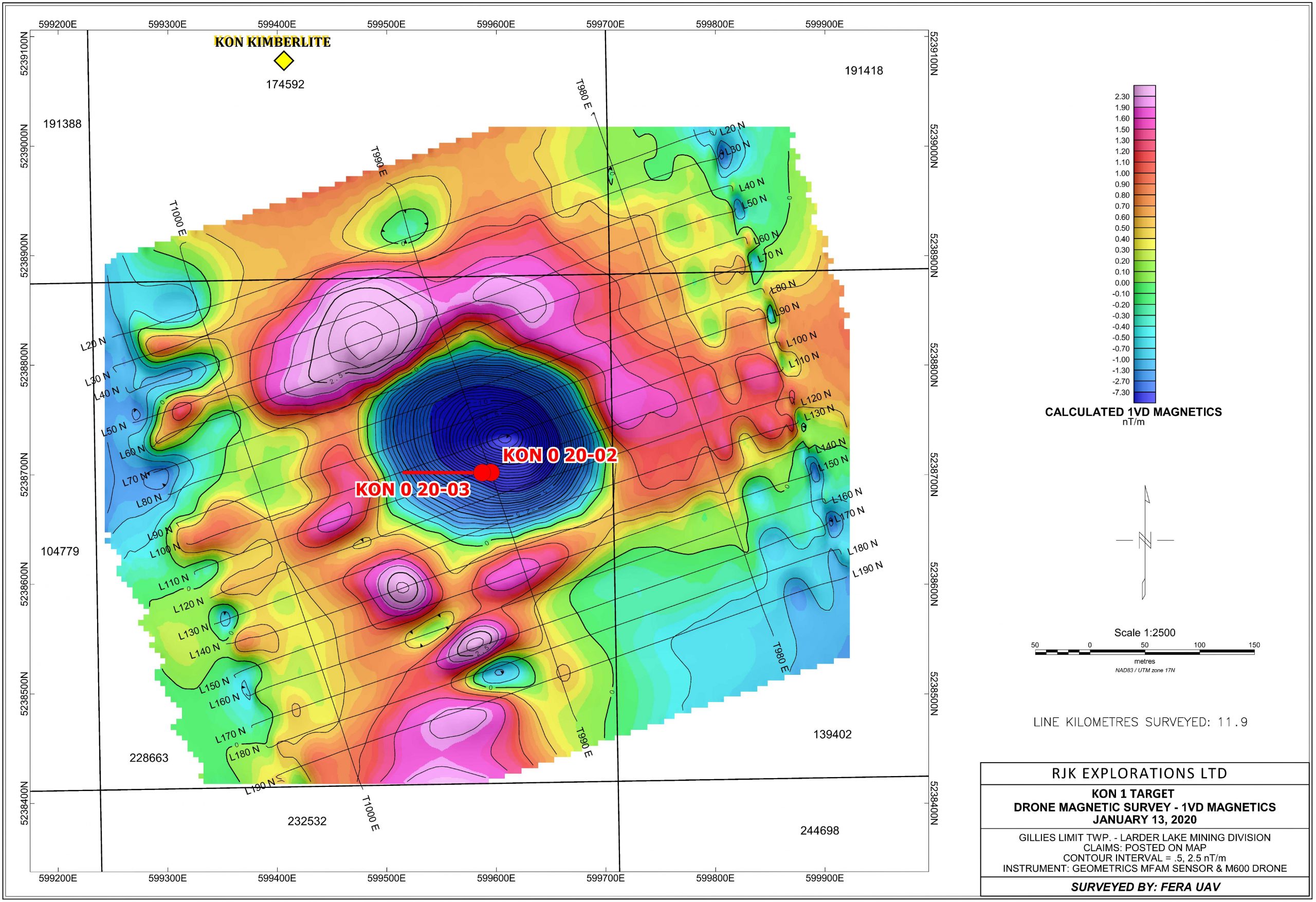
Structural Geology
Kimberlites are often associated with major faults, and local cross faults. They can also be associated with rock-type contacts. Both of RJK’s 2020 discoveries are located on major faults. RJK has over 30 additional drill targets for potential kimberlite discoveries.
The Cobalt Lake Fault and Kerr Lake Arch were associated with some of the richest silver veins in the world, and as well as significant cobalt deposits. Many of RJK’s targets are located along the Schumann Lake Arch and the Gleeson Lake Fault. There is a possibility to also discover silver and cobalt as well.
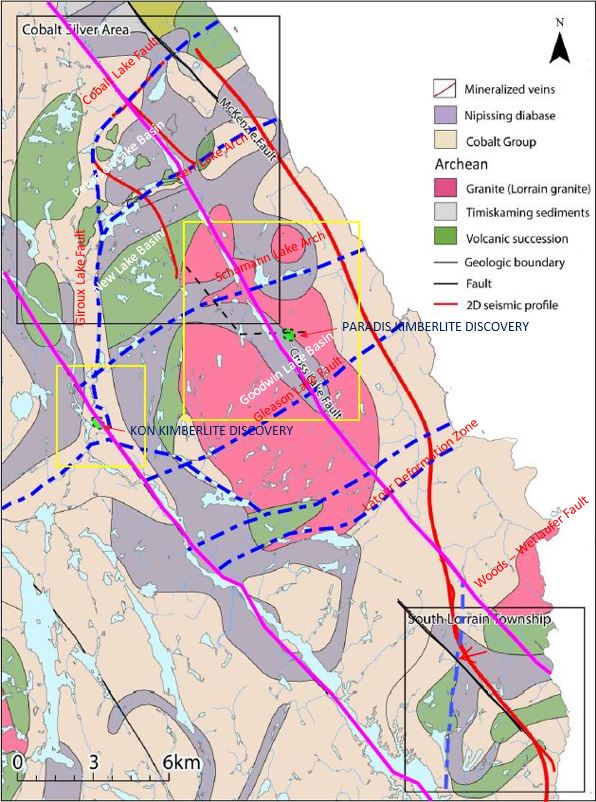
Silver and cobalt deposits to the north and south tend to be associated with contact points between Nipissing Diabase and Lorrain Granite, with the on-surface material located near the arches. If this theory continues south, both the Schumann Arch/Lightning Lake Fault and the Cross Lake Fault have near-surface silver and cobalt potential.
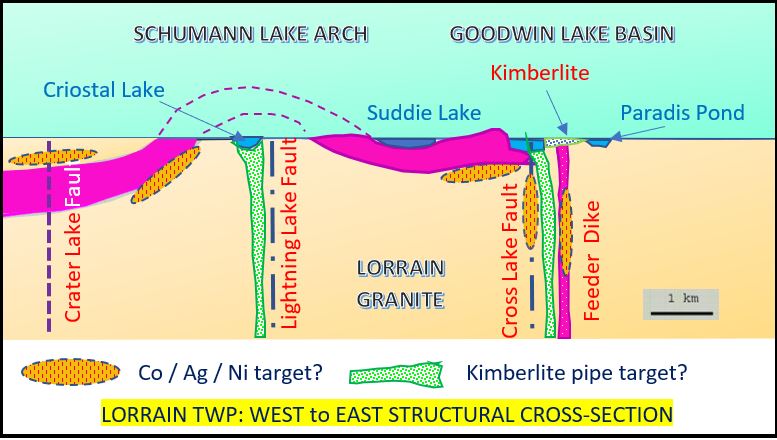
Watch RJK’s Videos for More Detail
Searching for the Source of the 800 Carat Yellow Nipissing Diamond
Watch our company introduction video below to learn the history of the Nipissing Diamond, and how RJK Explorations is working to uncover its source.
Be the First to Know About Our Diamond Discoveries.
Stock Symbols
TSX-V:RJX.A | US OTC:RJKAF
RJK on the Road to Discovery
RJK Explorations Ltd. is a mineral exploration company with a focus on diamonds gold, silver and base metals with its resource properties located in Ontario and Newfoundland.
RJK’s main exploration focus at this time will be expanding our land package and defining drill targets in search for the source of the 800 Carat Yellow Nipissing Diamond on our Bishop Claims near Cobalt, Ontario.
RJK is continuing exploration on the mineral claim blocks in Newfoundland. RJK conducted some initial drilling on the Rolling Pond Claim Block and will be continuing that exploration on a variety of targets.
Be the First to Know About Our Diamond Discoveries.






